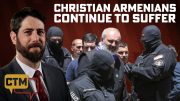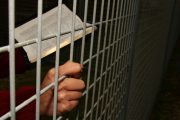Three international aid agencies issued a report on January 21 claiming that the Syrian government is responsible for the “systematic killing” of approximately 11,000 detainees held in Syrian jails.
The report was compiled by three international lawyers who are former prosecutors at international criminal tribunals: Sir Desmond de Silva QC, former chief prosecutor of the special court for Sierra Leone; Sir Geoffrey Nice QC, the former lead prosecutor of former Yugoslavian president Slobodan Milosevic; and Professor David Crane, who indicted President Charles Taylor of Liberia at the Sierra Leone court. The team prepared the report for the London law firm Carter-Ruck and Co. The agencies requesting the information are the International Committee of the Red Cross, various United Nations bodies, and Human Rights Watch.
Among the first media outlets to obtain the report were the U.K. Guardian and CNN.
One senior official from an international body told The Guardian, on condition of anonymity, “All I know after years of trying to get access is that this is likely to eventually shock the world. What we have seen in the [war crimes lawyers’] report broadly reflects what we have pieced together over the past few years.”
The Guardian reported that most of the 55,000 photos of the victims’ bodies contained in the report were shot by one official photographer, but many other photographers are attached to security units elsewhere in the country and are also likely to have been asked to provide photographic evidence.
The newspaper noted that since the uprisings began in March 2011, security units from Military Intelligence, Air Force Intelligence, and Political Security branches have detained large numbers of citizens and members of opposition fighting groups, especially in areas held by opposition fighting groups.
Some who have been released from detention facilities have told The Guardian and international investigators about the widespread use of summary executions.
(To access a PDF of the report, click here.)
Members of the investigative team included the three lawyers and a photographer with the Syrian military police (identified only as “Caesar” for security reasons) who worked secretly with a Syrian opposition group and later defected and fled the country. The report said that “Caesar” had, “during the course of his work, smuggled out some tens of thousands of images of corpses so photographed by his colleagues and himself.”
The report stated that the investigators secured the services of “three highly experienced forensic experts” to evaluate the photos and that “thirty-five images were uploaded directly to a secure server at Acume Forensics in the United Kingdom for assessment by Stephen Cole, an expert in digital imaging. It was confirmed to the inquiry team that these images were not digitally altered.”
Among the conclusions drawn by the investigating team from examining the photos:
• “A very significant percentage of the bodies showed emaciation.”
• “There were many bodies that showed bloodstaining. The presence of such staining alone in the absence of visible injury on the image was not considered to be evidence of injury; it was necessary for there to be an associated lesion that would cause bleeding.
• “These images did not show sufficient evidence to be categorized within either of the two groups above [“Equivocal Evidence of Inflicted Trauma” or “No apparent trauma”]. This does not mean that the individual had not sustained inflicted unlawful trauma, simply that this could not be confirmed from the evidence available.”
• “The experts took the view that they were examining physical findings only. They could not determine from the physical appearances whether torture had in fact taken place, as torture requires a state of mind in the individual or individuals inflicting the injuries.”
The report stated that Caesar had worked for the military police for about 13 years prior to his defection, and that during most of that time, his work was basically that of a crime scene investigator. With the start of the civil war, he said, his job changed to “taking pictures of killed detainees.”
When Caesar became suspicious and deeply concerned that the people whose bodies he was charged with photographing had not died of natural causes, but as a result of injuries inflicted by their captors, he sent digital copies of the photos on a flash drive to a trusted contact.
Caesar told the inquiry team that he had done this “for the sake of Syria and the Syrian people so that killers could be prosecuted to achieve justice.”
The report noted that “the vast majority of the images were of young men most likely between the ages of twenty and forty, with a minority more likely to be up to sixty years old. There were no children. Within the images seen there was only one female body and this was clothed and showed no signs of injury.”
The above descriptions appear to indicate that the victims were representative of the most common demographic of fighting units, rather than of a random civilian population, which would necessarily include many women and children.
The Syrian Opposition has reacted to news of the report by demanding that Assad’s representatives be excluded from the Geneva II talks, talks meant to lead to a new government in Syria. Upon arriving in Geneva ahead of peace talks, Badr Jamous, secretary-general of the National Coalition and member of its negotiating team, told Reuters: “We are here to fight a diplomatic battle to achieve the objectives of the Syrian revolution and the desires of the Syrian people.”
“We will not accept less than the removal of the criminal Bashar al-Assad and changing the regime and holding the murderers accountable.”
Referring to images taken by Caesar found in the report, Jamous said: “The images that we saw in the last few days indicate that this regime does not deserve less than being sent to stand trial in front of the International Criminal Court.”
As the details of the report commissioned by Carter-Ruck and Co. are further analyzed and other evidence surfaces, they may well confirm that the Assad regime is as brutal as many tyrannies that have existed in the Middle East and the rest of the world. That would not, however, mean that Assad’s opponents in the ongoing civil war are champions of political freedom.
As the people of Iran found after exchanging the Shah for the Islamic republic governed by a “supreme leader” that has ruled their nation ever since, fundamentalist Islamic governments often have worse human rights records than the Westernized autocratic rulers they have replaced. (According to the Minority Rights Group, in 1985 Iran became “the fourth country ever in the history of the United Nations” to be placed on the agenda of the General Assembly because of “the severity and the extent of this human rights record.”)
Furthermore, the opposition forces fighting to unseat Assad may be less motivated by Islamic ideals than the Ayatollah who replaced the Shah in Iran, with some elements being just garden-variety terrorists.
An AP report carried by the Boston Herald on January 21 quoted a statement from Islamic State of Iraq and the Levant (formerly called “al-Qaeda in Iraq”) leader Abu Bakr al-Baghdadi, identified as “The head of an al-Qaida-linked group in Syria,” who in an audio message posted online on Sunday called for reconciliation among the several rebel groups fighting the government, saying the Islamic State “is extending its hand so that we refrain from attacking each other and so that we can join forces” against Assad and his allies.
An AFP report published by the Washington Post last August noted:
A rebranded version of Iraq’s al-Qaeda affiliate is surging onto the front lines of the war in neighboring Syria, expanding into territory seized by other rebel groups and carving out the kind of sanctuaries that the U.S. military spent more than a decade fighting to prevent in Iraq and Afghanistan.
The article noted that the former Iraqi al-Qaeda affiliate, “now known as the Islamic State of Iraq and the Levant, is by no means the largest of the loosely aligned rebel organizations battling to overthrow Syrian President Bashar al-Assad.”
While opposing U.S. aid for the rebels, some members of Congress mentioned close connections between al-Qaeda and the rebel forces fighting Assad. In an interview with The Hill last August 27, former congressman Dennis Kucinich (D-Ohio) said that should President Obama approve an air strike in Syria, the U.S. military would “become Al Qaeda’s air force.”
Senator Rand Paul (R-Ky.) made similar comments during debate in Congress last year. “This is an important moment. You will be funding, today, the allies of al Qaeda,” Paul said during a hearing last May of the Senate Foreign Relations Committee. Paul was addressing his fellow senators, nearly all of whom voted to send arms to Syrian rebels.
The reason stated for sending U.S. troops to Afghanistan in late 2001 was to fight al-Qaeda, which had been identified as being responsible for the 9/11 attacks. However, somehow, the U.S. mission morphed into unseating Saddam Hussein, who was himself an enemy of al-Qaeda. Now the United States has been aiding al-Qaeda-affiliated rebels engaged in a civil war in Syria.
Even if the evidence found in the latest reports is confirmed, and Assad is found to be a brutal henchman, it is obvious that there are no “good guys” and “bad guys” in the Syrian civil war — “only “bad guys” and “worse guys.”
Photo of Assad’s troops arresting a member of the Free Syrian Army: AP Images
Related articles:
UN Invites Iran to Attend Geneva II Peace Conference
Lawmakers Seek to Stop Obama Arming Terrorists in Syria
Reports: U.S.-led Rebels Sent into Syria Before Chemical Attack
Rebel Atrocities in Syria Escalate, Sparking Alarm Over Obama Plan




